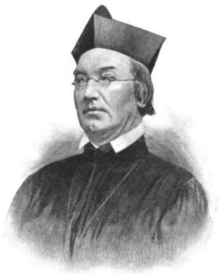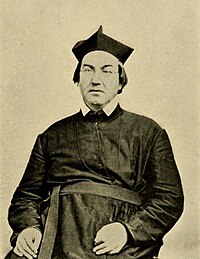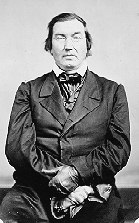John Early (educator)
John Early | |
|---|---|
 | |
| 26th & 28th President of Georgetown University | |
| In office 1870–1873 | |
| Preceded by | Bernard A. Maguire |
| Succeeded by | Patrick Francis Healy |
| In office 1858–1865 | |
| Preceded by | Bernard A. Maguire |
| Succeeded by | Bernard A. Maguire |
| 1st & 5th President of Loyola College in Maryland | |
| In office 1866–1870 | |
| Preceded by | Anthony F. Ciampi |
| Succeeded by | Edward Henchy |
| In office 1852–1858 | |
| Succeeded by | William Francis Clarke |
| 3rd President of the College of the Holy Cross | |
| In office 1848–1851 | |
| Preceded by | James A. Ryder |
| Succeeded by | Anthony F. Ciampi |
| Personal details | |
| Born | July 1, 1814 Maguiresbridge, County Fermanagh, Ireland |
| Died | May 23, 1873 (aged 58) Washington, D.C., United States |
| Resting place | Jesuit Community Cemetery |
| Alma mater | |
| Orders | |
| Ordination | July 1, 1845 |
John Early SJ (July 1, 1814 – May 23, 1873) was an Irish-American Catholic priest and Jesuit educator who was the president of the College of the Holy Cross and Georgetown University, as well as the founder and first president of Loyola College in Maryland. Born in Ireland, he emigrated to the United States at the age of nineteen. Upon his arrival, he enrolled at Mount St. Mary's Seminary in Maryland and entered the Society of Jesus, completing his education at Georgetown University in Washington, D.C.
Early became president of the College of the Holy Cross in 1848, where he unsuccessfully petitioned the Massachusetts legislature to charter the school. Four years later, he was charged with establishing Loyola College in Maryland, which was intended to educate the lay students who attended St. Mary's Seminary and College, which the Sulpicians sought to keep as a seminary only. While also serving as the first pastor of St. Ignatius Church, he oversaw the early years of Loyola College. He also established its high school division, which later became Loyola Blakefield. In 1858, Early left to become president of Georgetown University. During the Civil War, instruction continued uninterrupted, despite intermittent occupation by the Union Army and dwindling enrollment.
Early then returned to Loyola College in 1866 as president for four years, where he resumed the annual conferral of degrees. In 1870, he once again became president of Georgetown University. He died suddenly in his third year of office.
Early life
[edit]John Early was born on July 1, 1814, in Maguiresbridge, County Fermanagh, Ireland. He studied the classics at home, before entering the Armagh Academy in 1832,[1] which he attended for nine months. He then applied for admission to the seminary at St Patrick's College, Maynooth, but there were no vacancies, and he was not admitted.[2] As a result of his failure to gain admission to the seminary, Early emigrated to the United States in July 1833.[3]
Education in the United States
[edit]Seeking to become a priest,[4] Early enrolled at Mount St. Mary's Seminary in Emmitsburg, Maryland, the following September to study rhetoric. In February 1834, he advanced to Georgetown University in Georgetown, D.C. (now a part of Washington, D.C.),[3] where he remained until August 23, 1834,[5] when he entered the Society of Jesus, and proceeded to the novitiate in Frederick, Maryland. Upon the completion of his novitiate in 1836, Early returned to Georgetown for the next nine years to study philosophy and theology. While studying, he also taught and was head prefect during the academic year of 1843 to 1844.[3]
On July 1, 1845,[6] Early was ordained a priest at Holy Trinity Church in Georgetown. He then taught philosophy at Georgetown for two years, and ministered as a missionary in Laurel, Maryland. He began ministering at Old St. Joseph's Church in Philadelphia in 1847.[3] He professed his fourth vow on September 8, 1853.[5]
College of the Holy Cross
[edit]On August 29, 1848, Early was appointed president of the College of the Holy Cross,[7] succeeding James A. Ryder.[8] His most immediate concern was securing a charter for the college, which would allow it to confer degrees on the four students who were ready to graduate the following year.[7] Up to that point, the college awarded degrees in the name of Georgetown University, as it had been denied a charter.[9] In March 1849, Early petitioned the Massachusetts General Court to charter the college,[7] and appeared before the legislature alongside Orestes Brownson.[10]
In accordance with Bishop John Bernard Fitzpatrick's insistence, the petition for a charter included a provision that the college would be exclusively for the "benefit of one [Roman Catholic] denomination only, and, therefore, having no claims whatever upon the Commonwealth." This was met with opposition in the House of Representatives,[9] which was motivated by a mix of both anti-Catholicism and concerns about the separation of church and state.[11] This provision was eventually removed,[12] but the legislature nonetheless voted to deny the charter.[13] Early's term came to an end in 1851, and he was succeeded by Anthony F. Ciampi.[14] Early then returned to Frederick, Maryland for a year.[3]
Founding Loyola College in Maryland
[edit]
In 1852, the Sulpician priests who ran St. Mary's Seminary and College in Baltimore decided that they would discontinue the college portion, which educated lay students, and focus only on the seminary. They asked the Jesuits to continue educating the laity in the city, and in response, the Jesuits established Loyola College in Maryland on September 15, 1852, in two rented houses on Holliday Street in Baltimore.[15] Early was appointed the school's first president.[16] The Maryland General Assembly granted Loyola College a charter in April 1853.[15] At the same time as the college's founding, St. Ignatius Church. Early became its first pastor, and oversaw building of the church in August 1855, adjacent to the college. The church was consecrated on August 15, 1856.[17] Early is also considered the founder of Loyola Blakefield, which was established as Loyola High School and operated as a component of Loyola College until its separation in 1921.[18]
Two years after its founding, the college purchased a plot of land on the corner of North Calvert and Madison Streets. Construction of a college building was completed in February 1855, and the college officially relocated to the new campus on February 22.[16] Being called to Georgetown University, Early's tenure as president came to an end in the autumn of 1858,[19] and he was succeeded by William Francis Clarke.[20] He remained as pastor of St. Ignatius until October 1858, and was succeeded by Clarke.[17]
Georgetown University
[edit]Early was appointed to succeed Bernard A. Maguire as president of Georgetown University in 1858. He took office during a time of great national tension, preceding the Civil War.[21] Soon thereafter, he received notice from the College of William & Mary that its library had been destroyed by fire; Early donated a case of 100 books to aid it in rebuilding.[22] In 1860, Abraham Lincoln was elected president of the United States, and the southern states seceded from the Union. At the start of the academic year of 1861, many southern students left the college for their homes,[23] followed by northern students doing the same.[24] Though it looked doubtful that the college would be able to continue operating,[24] Georgetown endured as an active school, carrying on with classes throughout the Civil War for the few remaining students.[4]
On May 4, 1861, Early was notified that the college would be commandeered by the 69th Infantry Regiment of the New York National Guard,[24] which remained until May 24. Shortly thereafter, he was again informed that the school would be occupied by the 79th New York Regiment, which remained from June 3 to July 4.[25] The college was occupied for a third time on August 29, 1862, as a hospital for the soldiers of Major General John Pope's army wounded at the Second Battle of Bull Run.[26] Due to the many wounded, Holy Trinity Church was also commandeered. The campus remained a military hospital until February 2, 1863.[27]
Early's term as president came to an end in 1865, and he was succeeded by his predecessor, Maguire, on January 1, 1866.[3] Early then went to Boston, where he engaged in missionary work until July of that year.[3]
Return to Loyola College
[edit]
Early was once again appointed president of Loyola College in the summer of 1866,[28] to replace Ciampi.[29] He also again became pastor of St. Ignatius Church.[17] The college fared well during his leadership. While there had been a pause in the conferral of degrees during the Civil War, Early saw that students completed their course of study and received degrees. The Loyola Dramatic Association, which was founded in 1865, was especially active during his term.[30] After four years, his presidency came to an end in July 1870, when he again returned to Georgetown.[31] He was succeeded by Edward Henchy as president of Loyola,[29] and as pastor of St. Ignatius.[32]
Later years at Georgetown
[edit]Early returned to Georgetown as president on July 14, 1870, to replace Maguire.[33][34] Following King Victor Emmanuel II's invasion of Rome, the students held a meeting to denounce the invasion as an indignity to the pope,[33] and voted to contribute a Peter's Pence to the pontiff.[35] The university's Law Department had been established at the end of Maguire's presidency, and it began its first classes in October 1870.[36] The Georgetown College Journal began publishing in December 1872,[37] as the university's first student-produced newspaper.[38]
That year, Early began to experience the effects of a disease of his kidneys, which affected his eyesight.[3][39] As a result, the vice president, Patrick Francis Healy, largely took over the administration of the university; Healy would later succeed Early as president.[40] On May 22, 1873, Early suffered a stroke,[3] which left him unable to speak and half his body paralyzed.[1] He died the following day.[2] It was estimated that 5,000 people attended his funeral, and he was buried in the Jesuit Community Cemetery at Georgetown.[3][31]
References
[edit]Citations
[edit]- ^ a b Shea 1891, p. 246
- ^ a b Biographical Supplement: Fr. John Early 1890, p. 112
- ^ a b c d e f g h i j Biographical Supplement: Fr. John Early 1890, p. 113
- ^ a b Report of the Commissioner of Education 1874, p. 450
- ^ a b Mendizàbal 1972, p. 75
- ^ "Rev. John Early, S.J." College of the Holy Cross. Archived from the original on March 20, 2020. Retrieved March 20, 2020.
- ^ a b c Devitt 1935, p. 217
- ^ Kuzniewski 1999, p. 52
- ^ a b Kuzniewski 1999, p. 70
- ^ Devitt 1935, p. 218
- ^ Kuzniewski 1999, p. 71
- ^ Kuzniewski 1999, p. 72
- ^ Kuzniewski 1999, p. 73
- ^ Devitt 1935, p. 237
- ^ a b Ryan 1903, p. 10
- ^ a b Ryan 1903, p. 11
- ^ a b c The Catholic Church in the United States of America 1914, p. 67
- ^ "History". Loyola Blakefield. Archived from the original on November 29, 2020. Retrieved February 23, 2021.
- ^ Ryan 1903, p. 16
- ^ Ryan 1903, p. 20
- ^ Shea 1891, p. 198
- ^ Shea 1891, p. 199
- ^ Shea 1891, p. 203
- ^ a b c Shea 1891, p. 204
- ^ Shea 1891, p. 205
- ^ Shea 1891, p. 207
- ^ Shea 1891, p. 208
- ^ Ryan 1903, p. 52
- ^ a b Ryan 1903, p. 227
- ^ Ryan 1903, p. 53
- ^ a b Ryan 1903, p. 61
- ^ Ryan 1903, p. 81
- ^ a b Shea 1891, p. 235
- ^ Shea 1891, p. 233
- ^ Shea 1891, p. 236
- ^ Shea 1891, p. 241
- ^ Shea 1891, p. 244
- ^ "Georgetown College Journal". Georgetown University Library. Archived from the original on April 24, 2018. Retrieved March 20, 2020.
- ^ Shea 1891, p. 247
- ^ O'Donnell 1951, p. 130
Sources
[edit]- "Biographical Supplement: Fr. John Early" (PDF). Woodstock Letters. XIX (1): 112–113. February 1890. Archived (PDF) from the original on March 19, 2020. Retrieved March 19, 2020 – via Jesuit Archives.
- Devitt, Edward I. (June 1935). "History of the Maryland-New York Province XV: College of the Holy Cross, Worcester, Mass" (PDF). Woodstock Letters. LXIV (2): 204–237. Archived (PDF) from the original on March 10, 2020. Retrieved March 19, 2020 – via Jesuit Archives.
- Kuzniewski, Anthony J. (1999). Thy Honored Name: A History of the College of the Holy Cross, 1843–1994. Washington, D.C.: Catholic University of America Press. ISBN 978-0-81320-911-1. Archived from the original on March 19, 2020. Retrieved March 19, 2020 – via Google Books.
- Mendizàbal, Rufo (1972). Catalogus defunctorum in renata Societate Iesu ab a. 1814 ad a. 1970 [Catalogue of the dead in a revival of the Society of Jesus from 1814 to 1970] (in Latin). Rome. pp. 60–90. OCLC 884102. Archived from the original on March 19, 2020. Retrieved March 19, 2020 – via Jesuit Archives.
{{cite book}}: CS1 maint: location missing publisher (link) - O'Donnell, Thomas J. (February 1951). "For Bread and Wine: Georgetown's President" (PDF). Woodstock Letters. LXXX (1): 99–142. Archived (PDF) from the original on March 19, 2020. Retrieved March 19, 2020 – via Jesuit Archives.
- Report of the Commissioner of Education for the Year 1873 (Report). Washington, D.C.: Government Printing Office. 1874. OCLC 1076491887. Archived from the original on March 19, 2020. Retrieved March 19, 2020.
- Ryan, John J. (1903). Historical Sketch of Loyola College, Baltimore, 1852–1902. OCLC 1615190. Retrieved December 13, 2019 – via Internet Archive.
- Shea, John Gilmary (1891). "Chapter XXV: Father John Early". Memorial of the First Century of Georgetown College, D.C.: Comprising a History of Georgetown University. Vol. 3. Washington, D.C.: P. F. Collier. pp. 198–213, 235–247. OCLC 960066298. Archived from the original on March 19, 2020. Retrieved March 19, 2020 – via Google Books.
- The Catholic Church in the United States of America: Undertaken to Celebrate the Golden Jubilee of His Holiness, Pope Pius X. Vol. 3. New York: Catholic Editing Company. 1914. OCLC 972339830. Archived from the original on March 19, 2020. Retrieved March 19, 2020 – via Google Books.
External links
[edit] Media related to John Early (educator) at Wikimedia Commons
Media related to John Early (educator) at Wikimedia Commons
- 1814 births
- 1873 deaths
- People from County Fermanagh
- 19th-century Irish Jesuits
- American Roman Catholic clergy of Irish descent
- 19th-century American Jesuits
- People educated at The Royal School, Armagh
- St. Stanislaus Novitiate (Frederick, Maryland) alumni
- Mount St. Mary's University alumni
- Georgetown University College of Arts & Sciences alumni
- Irish emigrants to the United States
- Presidents of Georgetown University
- Presidents of Loyola University Maryland
- Presidents of the College of the Holy Cross
- Pastors of St. Ignatius Church (Baltimore)
- Burials at the Georgetown University Jesuit Community Cemetery
- People of Washington, D.C., in the American Civil War
- University and college founders
- Deans and Prefects of Studies of the Georgetown University College of Arts & Sciences
